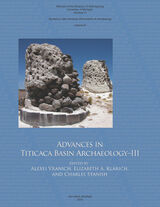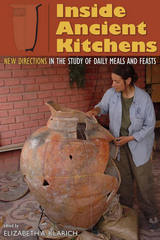3 books about Klarich, Elizabeth A.

Advances in Titicaca Basin Archaeology–III
Edited by Alexei Vranich, Elizabeth A. Klarich and Charles Stanish
University of Michigan Press, 2012
The focus of this volume is the northern Titicaca Basin, an area once belonging to the quarter of the Inka Empire called Collasuyu. The original settlers around the lake had to adapt to living at more than 12,000 feet, but as this volume shows so well, this high-altitude environment supported a very long developmental sequence.
[more]

Enduring Monuments
Formative Period Transformations at Pukara, Peru
Elizabeth A. Klarich
University Press of Colorado, 2025
The culmination of over a decade of research, Enduring Monuments traces the architectural life histories of monumental complexes and public spaces of the Pukara site in the Lake Titicaca Basin. Using data from three distinct areas—the Qalasaya complex, the Central Pampa, and the Northern Platform—Elizabeth A. Klarich provides a powerful diachronic and comparative perspective for understanding social and political transformations during the Late Formative period in Peru.
In the early twentieth century, Peruvian archaeologists Luis E. Valcárcel and Julio C. Tello visited Pukara and shared images of its multicolored pottery and unique stone sculptures with colleagues across the world. A number of both small-scale and multiyear field projects have followed, with goals of refining Lake Titicaca Basin cultural chronologies, tracking Pukara-style material culture in the south-central Andes, restoring the structural integrity of the Qalasaya, and documenting the reoccupations of Pukara by Colla, Inca, and early Spanish colonial populations. Enduring Monuments synthesizes the findings of these diverse projects and shares the results of fieldwork and artifact analysis by the Pukara Archaeological Project since 2000.
Using a “building biography” approach that tracks initial construction, major remodeling, and subsequent expansion efforts during the Middle and Late Formative periods (400 BC–AD 200), Klarich highlights transformations in material culture, settlement patterns, social hierarchy, and daily practices at Pukara and contemporaneous sites across the Titicaca Basin and situates Formative period Pukara within the vast anthropological and archaeological literature addressing monumentality, ritual practice, and incipient urbanism in complex societies in South America and beyond.
In the early twentieth century, Peruvian archaeologists Luis E. Valcárcel and Julio C. Tello visited Pukara and shared images of its multicolored pottery and unique stone sculptures with colleagues across the world. A number of both small-scale and multiyear field projects have followed, with goals of refining Lake Titicaca Basin cultural chronologies, tracking Pukara-style material culture in the south-central Andes, restoring the structural integrity of the Qalasaya, and documenting the reoccupations of Pukara by Colla, Inca, and early Spanish colonial populations. Enduring Monuments synthesizes the findings of these diverse projects and shares the results of fieldwork and artifact analysis by the Pukara Archaeological Project since 2000.
Using a “building biography” approach that tracks initial construction, major remodeling, and subsequent expansion efforts during the Middle and Late Formative periods (400 BC–AD 200), Klarich highlights transformations in material culture, settlement patterns, social hierarchy, and daily practices at Pukara and contemporaneous sites across the Titicaca Basin and situates Formative period Pukara within the vast anthropological and archaeological literature addressing monumentality, ritual practice, and incipient urbanism in complex societies in South America and beyond.
[more]

Inside Ancient Kitchens
New Directions in the Study of Daily Meals and Feasts
Elizabeth A. Klarich
University Press of Colorado, 2010
The anthropology of food is an area of research in which economic, social, and political dynamics interact in incredibly complex ways. Using archaeological case studies from around the globe, Inside Ancient Kitchens presents new perspectives on the comparative study of prehistoric meals from Peru to the Philippines. Inside Ancient Kitchens builds upon the last decade of feasting studies and presents two unique goals for broadening the understanding of prehistoric meals. First, the volume focuses on the study of meal preparation through the analysis of temporary and permanent kitchen areas. This move to focus "behind the scenes" is aimed at determining how, where, and by whom meals were financed and prepared. Secondly, data from these preparation contexts are used to differentiate between household-level and suprahousehold-level meals in each case study, resulting in more nuanced typologies of daily meals, feasts, and other food-related events. Inside Ancient Kitchens presents an important step in the development of new methodological and theoretical approaches within the anthropology of food and will be of great interest to scholars studying the social dynamics, labor organization, and political relationships underlying prehistoric meals.
[more]
READERS
Browse our collection.
PUBLISHERS
See BiblioVault's publisher services.
STUDENT SERVICES
Files for college accessibility offices.
UChicago Accessibility Resources
home | accessibility | search | about | contact us
BiblioVault ® 2001 - 2025
The University of Chicago Press









